An introduction to the idyllic lagoons of this beautiful and cruisable Pacific stopover (published September 2014)
Sailing New Caledonia? “It’s horrible!” one sailor complained. “The water temperature today is only 25°C!” That’s a frigid 77°F, to us North Americans.
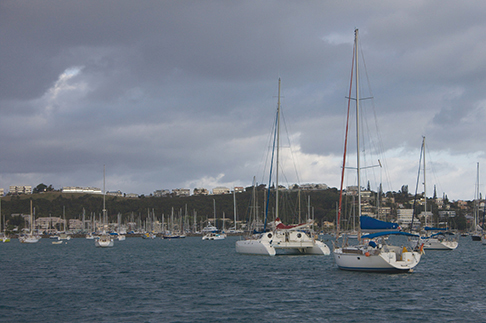
Yes, New Caledonia was spoiling us rotten with its balmy temperatures, French cuisine and abundant sea life. Plus, a dozen perfect anchorages within a startlingly turquoise lagoon only a short sail away from first-rate provisioning in the capital city. Not to mention inland delights for those with the time and gumption to step away from the coast.
For two months, New Caledonia blessed us with “calendar” cruising. No matter where we pointed the camera, we had an award-winning shot. It was a different kind of cruising than we had experienced thus far on our Pacific crossing—short distances in a compact area with periodic runs to replenish supplies, meet visitors or pick up parts. Refreshingly, charts are spot-on and aids to navigation well-maintained. At the same time, reefs and isolated dangers keep things just challenging enough. It’s an aquatic wonderland accessible to part-timers and long-range cruisers alike thanks to numerous charter bases operating out of Noumea.
Every islet in the lagoon has its own charm, it’s own appeal. Many rival the most remote atolls of the Pacific in pristine beauty. And despite their proximity to the capital, we found ourselves blissfully alone at many a picture perfect anchorage. Case in point, at the remote Cook Island of Suwarrow we were one of thirty boats. In New Caledonia, we claimed entire anchorages for ourselves time and time again. Of course, numbers swell on weekends when working sailors flee the mainland. That’s when we, the flexible, head to the outermost islands or back to the capital for supplies.
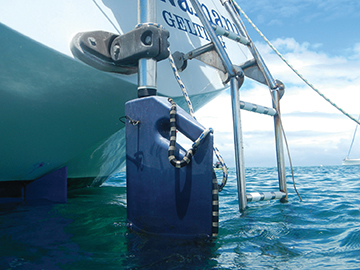
We arrived in New Caledonia with little idea of what to expect and left chock full of azure memories. May you do the same, with a little help from this introduction to the area’s highlights. First, we’ll have a look at the capital city, Noumea; second, explore the islands on Noumea’s doorstep; and finally, move on to the true jewels farther afield.
NOUMEA
Call it ugly, call it busy, call it characterless; Noumea is par for the course as far as South Pacific cities go. Like Tahiti’s Papeete, it’s a major boating hub with well-stocked grocery stores, chandlers and yacht services of all types. Prices, like everywhere in the Pacific, are high, except for staples like the ubiquitous baguette. A few colonial-era buildings, the market place and central park provide small doses of eye candy in an otherwise featureless cityscape. There are a number of interesting museums in Noumea, starting with the outstanding Musee de Nouvelle Caledonie (with excellent, bilingual exhibits covering the breadth of Melanesia) and the Maritime Museum. Anyone waiting out a longer period in the city can enjoy beaches like Baie des Citrons and Anse Vata or take in hilltop views from Ouen Toro.
Between acres of anchorage room and Port Moselle marina, you can always find a “parking” spot in Noumea, although swinging space is tight. Clearing in and out requires some legwork, but most officials are friendly English-speakers, and the process is free. Port Moselle Marina gives priority to overseas arrivals and will facilitate clearance procedures whether you are a guest or not. Generally, the visitor’s dock turns over rapidly and it is sometimes possible to sub-let a private slip there for a longer stay.
Noumea was one of the few areas where we could reliably access the Internet, either through iNet (about $10 a week; buy at newsstands) or the marina WiFi. The snail-paced connection, however, pales in comparison to the excellent services back in Fiji.
ON NOUMEA’S DOORSTEP
Just a short sail out of Noumea lie an embarrassment of riches in terms of anchorages. But even that hop is enough to transport the jaded citygoer to the wonders of the aquarium-like lagoon. Islands like Ilot Maitre and Laregnere fall within protected marine sanctuaries and shelter the richest sealife. The turtles, sharks, rays and occasional dugongs there are a confident lot and therefore much easier to snorkel among than the flighty denizens of unprotected areas. The marine reserves also provide free moorings—though it pays to check the line before trusting your boat to it.
For a quick escape from the city nothing beats Ilot Maitre, just four miles south of Noumea (see map, number 1). The proximity means weekend crowds of dozens, but the island falls back to an easy slumber on workdays. The water clarity and marine life are outstanding and dozens of mooring buoys await the lazy cruiser. Although the shoreline is marred by hotel bungalows, a drink at the hotel bar buys you Internet access, making Maitre a good place to monitor weather reports for an upcoming passage while staying within spitting distance of the city for a final provisioning run.
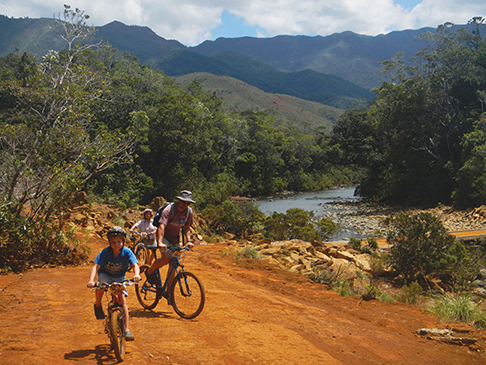
Ilot Mbe Kouen, 14 miles northwest of Noumea, feels like a place on the edge of the world (2). We shared this reef-encircled anchorage with just one other boat and spent days playing Robinson Crusoe on the sandy cay. It’s also a reliable spot for dugong sightings; at least one regular spiced up our quiet days. On weekends, the “crowd” swelled to six boats, many of them kite surfers who put on a spectacular show. There’s no wind shelter at Mbe Kouen, but the reef proved to be an effective barrier during a period of 30-knot southeasterlies we sat out, comfortably anchored in 15 feet over a sandy bottom.
Ilot Laregnere (3) and Ilot Signal (4) are neighboring islands and protected marine reserves with free mooring buoys seven miles from Noumea. The wildlife is well accustomed to visitors. We were able to snorkel casually alongside sea turtles here rather than stealing furtive glances as in other areas. Another reptile well represented is the Tricot Raye, New Caledonia’s striped sea snake. They’re fascinating creatures that move easily between land and sea. Though poisonous, these sea snakes are perfectly safe, as their venom is located so far back in the throat, you’d have to force one of the poor creatures into biting you. A walk around either island provides an opportunity to stretch your legs, beach-comb and observe nesting sea birds.
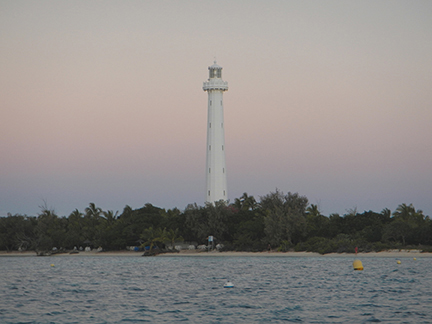
Phare Amedee (a lighthouse) is a New Caledonian landmark (5). The tiny island and marine reserve are only 15 miles from the capital, but feel like a different world. The slender lighthouse was built in France in 1862, then shipped and reassembled here. It’s open to visitors for spectacular bird’s-eye views over the lagoon (daily from 11:00 to noon—more or less—for a small fee). The island and reef offer only partial protection, so the mooring field can get rolly. Otherwise, it’s a lovely place right at the edge of the ocean and Boulari Pass, a perfect staging point for a passage west. Reef sharks, turtles, sea snakes and sea birds are all plentiful here, drawing the occasional excursion boat from Noumea. At those times, the island feels too busy with its snack bar and SCUBA center, but things settle down quickly in the afternoons. Otherwise, we reveled in the special atmosphere of the place, spending a magically calm night under the sweeping beam of the lighthouse.
Ile Uere is a horseshoe-shaped island just outside Noumea with excellent protection and holding (6). It’s a pretty spot with nice night views of the city lights just outside the hustle and bustle of it all. It’s the perfect place to ride out a storm or escape the city for a few days, and a great place for young children who enjoy calm water. Avoid weekends, though, when the watersports crowd takes over.
FARTHER AFIELD

The following anchorages are either a long day’s sail or a two-day hop from Noumea and therefore attract fewer weekend warriors. Ilot Mato and Kouare are idyllic drops of green in the blue lagoon, while Prony offers a taste of an entirely different landscape in ochre and red. As for Ile des Pins, well, that gem is in a class of its own.
Ilot Mato is an excellent stopover point for those heading to Ile des Pins and an anomaly as one of the few high islands in the lagoon (7). Its forty meter peak offers a lovely panorama of the southern end of the lagoon with its incredible aquamarine color palate. The reefs ringing the anchorage provide nice, if not spectacular snorkeling, with glimpses of reef sharks along the way. There’s space for dozens of boats, though we had this beauty all to ourselves in the middle of the week.
The best snorkeling we found in the lagoon was at Ilot Kouare (8). Water clarity varies with the tide, but hit it just right and the craggy, colorful reef will amaze you with its variety, length and multi-storey structures. There are three different anchorages on all sides of the island, making it a safe bet in all but the hardest blow.
Baie de Prony is a wide bay from which several fingers branch out, a mini cruising ground of its own (9). A winding trail leads from Bonne Anse, the southeasternmost arm of the bay, to the lighthouse and whale observation post on the top of the hill, with views all the way to Ile des Pins. At the head of the bay is Baie du Carenage, a hurricane hole of a creek with a natural hot spring. The landscape is harsh but beautiful in its own way, with red earth and the low scrub typical of the mainland.
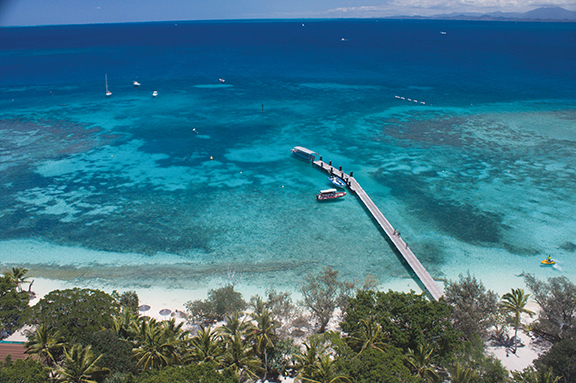
Ile des Pins deserves an article in itself (10). For us, this eight by eight mile island was one of the highlights of the entire Pacific for its laid-back character and variety. Baie de Kuto is the perfect place for an extended layover; we spent a happy ten days there in an picture-prefect bay ringed by the namesake pines. There’s a boulangerie and small shop where you can top up on fresh supplies. You can treat yourself to a meal at one of the hotels or just hide away from it all. And yes, there’s even iNet Internet coverage out in the bay.
Back to back with Kuto is Baie de Kanumera with its gorgeous shoreline and pleasant snorkeling. A short walk brings you to the ruins of the jail that housed France’s political exiles in the 1870s. For an active day out, hike the 262 meter Pic N’ga or rent a bike from one of the low-key resorts to visit the old town of Vao and pretty Baie de Saint Joseph, home port to many traditional pirogues (sailing canoes). The hardy can even circle the entire island with a stop at Baie d’Oro with its piscine naturelle (natural pool).
The catch? Kuto is a favorite of cruise ships, which visit as often as three times per week and disgorge thousands of sunburned passengers at a time. However, these visitors herd at one end of the beach, leaving wide swaths of peace and quiet for those willing to walk a few minutes. The advantage of cruise ship day is that local families set up barbecue stalls along the beach, your opportunity for a break from standard galley fare.
Weather protection is another issue. While Baie de Kuto is a deep scoop in the island’s shape, heavy westerlies will occasionally heave into the bay. That’s the time to circle around to Kanumera. While Kuto may have a dozen or more yachts at a time (rest assured, the bay can hold many times that), other parts of the island see fewer boats, such as beautiful Baie de Ouameo. A number of offlying islets offer good day or overnight anchorages, as well.
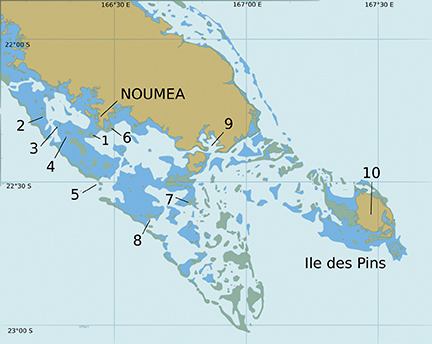
1 Ilot Maitre 2 Ilot Mbe Kouen 3 Ilot Laregnere 4 Ilot Signal 5 Phare Amedee 6 Ile Uere
7 Ilot Mato 8 Ilot Kouare 9 Baie de Prony 10 Ile des Pins
All the highlights described here cluster around the southwest end of New Caledonia. Sailors with more time can explore more of the lagoon, heading northwest along the leeward shore of the mainland, or better yet, overnight out to the Loyalty Islands to the east. Local sailors give Ouvea (the northernmost of the three Loyalties) top marks, thanks to its beautiful lagoon.
Still, most cruisers “confine” themselves to the southwest corner of the lagoon, an experience as liberating as any in the South Pacific. Again and again, we were amazed at how quickly we could get away from it all just in the compact area described. In fact, we postponed our departure for Australia again and again, drinking our fill of the lagoon’s wonders for a full two months before bidding it a fond au revoir—until we meet again.
Nadine Slavinski is the author of Lesson Plans Ahoy: Hands-On Learning for Sailing Children and Home Schooling Sailors. Together with her husband and young son, she cruised the Atlantic and Pacific aboard her 1981 Dufour 35, Namani. She is currently at work on The Silver Spider, a novel of sailing and suspense, as well as Pacific Crossing Notes: A Sailor’s Guide to the Coconut Milk Run (see nslavinski.com for more information and free resources on home schooling).
INLAND SIGHTS
Inland travel will reveal an entirely different side of New Caledonia, rugged red mountains sprinkled with sleepy Kanak (native Melanesian) hamlets. With a one or two day car rental (check Pointe Rouge near Orphelinat for the best rates), it’s possible to quickly tour north to Bourail with its intriguing coastline and Sarramea for lush mountain scenery. The most spectacular coastal scenery is found in the far north in places like Voh and Hienghene. Our top pick for an active day trip is Riviere Bleu, a Provincial Park located ninety minutes south of Noumea by car. There, we exercised long-forgotten muscles with a combination mountain bike/kayak excursion (call ahead to reserve; see www.sudloisirs.nc). The hiking trails at Riviere Bleu are a good bet for spotting wild cagou, the graceful national bird of New Caledonia.
PRACTICALITIES Money: The Cour de Franc Pacifique (CFP) is a currency tied to the Euro, familiar to cruisers who have visited French Polynesia (have a close look: every bill has a Polynesian and a Melanesian-themed side). Provisioning: Carrefour and Casino supermarkets are both in walking distance of the Noumea anchorages. Cooking: Only butane is available in New Caledonia, and only approved bottles (the round blue type) will be filled. To fill any other type of bottle, you will need to gravity feed using an adaptor. Customs and clearance: quick, easy and free for a three month stay. Ask for the information sheet at Port Moselle marina that details the procedure and locations. Unlike French Polynesia, New Caledonia does not require a bond for visiting North American sailors. Cruising guide: The Cruising Guide to New Caledonia, an excellent electronic guide, is available from cruising-newcaledonia.com. Based on the 1996 print book and updated in 2012. Information: Check the outstanding English-language website www.newcaledoniatoday.wordpress.com—with everything from tips on day trips to local culture to the latest news and events.

















